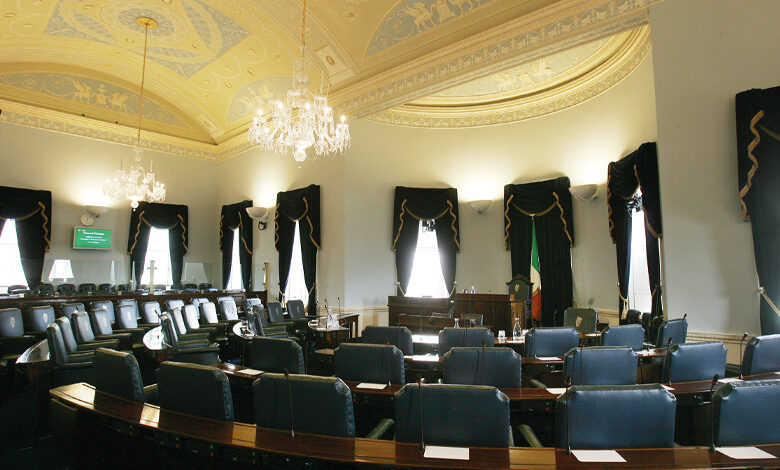100 years of Seanad Éireann

December 2022 marked the centenary of the foundation of Seanad Éireann, the upper house of the Oireachtas which has survived the curbing of its powers and proposed abolition over its century of legislative scrutiny.
Then-Taoiseach Micheál Martin TD marked the commemoration with a rare speech before the upper house on 11 December 2022, outlining his belief that, upon its foundation, the Seanad “was not representative, nor indeed was it intended to be”.
“It was first and foremost a membership defined by finding a place in the new State for those who had not supported its creation and by making a statement about the place of minorities.”
The first Seanad was comprised of a membership with a small majority of Catholics (36), with 20 Protestants, three Quakers, and one Jewish member. It additionally included seven members of a British aristocratic background.
Martin went on to illustrate how the Seanad has helped integrate women, Protestants, and minorities into the top level of Irish politics, referring to the appointments of Douglas Hyde and Mary Robinson, both of whom went on to assume the role of President of Ireland.
An ambiguous role
Initially based on the British House of Lords’ model of a chamber for the intelligentsia with the necessary expertise to scrutinise legislation, the Seanad’s scope and remit has been changed fundamentally on two occasions, with 1928 reducing its accountability whilst enhancing its powers, and 1937 greatly curtailing its powers.
The democratic deficit argument which is often attributed to the modern Seanad manifested itself to a lesser degree in the first Seanad, with the Free State Constitution outlining that the upper house would be comprised of 60 members, each elected on 12-year terms, with one-third of the house to be up for election every three years. This proposal was abolished in the 1928 reforms, with 1925 being the only year in which direct elections were held for the Seanad.
In 1937, facing a Seanad which was proving to be problematic for the passage of his government’s legislation, former Taoiseach Éamon de Valera ensured that the newly ratified Bunreacht na hÉireann provided clarity that the Dáil was the house with the legitimacy to pass legislation.
Bunreacht na hÉireann presented a major curb on the powers of the Seanad, ensuring the level of checks and balanced afforded on the Seanad were minimal, whilst providing for a number of technical measures from which the Seanad can avail, although these have rarely been enacted.
Indeed, only on two occasions has the Seanad voted against a Bill which was passed by the Dáil. In 1958, de Valera proposed a first-past-the-post electoral system which could have increased Fianna Fáil’s majority in the Dáil. Whilst this Bill was passed in the Dáil in 1959 by a majority of 19, the Seanad rejected the Bill by a majority of one.
Despite this opposition, the Dáil availed of its power to pass legislation which had been rejected by the Seanad after 90 days, with the proposal eventually being defeated in a referendum in 1959.
In its modern form, the Seanad has the powers to delay a bill by up to 90 days, whereas the original Seanad which operated in the Free State had the power to delay legislation by an initial period of up to nine months, which was extended in 1928 to a period of delay of up to 20 months. The aim of this this was to provide an enhanced level of checks and balances.
The modern Seanad has 11 members who are appointed directly by the Taoiseach, with no checks and balances on the process and no consideration of the Government’s majority in the Dáil.
Whilst Senators, in theory, are not supposed to be political representatives, the Taoiseach’s appointments are usually used to appoint members of whichever party the Taoiseach is a member of, as manifested by Micheál Martin’s decision not to re-nominate Ian Marshall when making his 2020 appointments, instead ensuring that the Government parties’ seats were maximised.
Threat of abolition
2013 presented the greatest threat to the Seanad as an institution, with a campaign supported by Enda Kenny’s government to abolish the house, pointing to the potential to save up to €20 million and reduce the number of politicians in the State, a proposal which was then seen to be popular in an Ireland which was crippled by economic crisis and mass discontent towards its politicians.
Whilst Fine Gael, Labour, and Sinn Féin supported the Seanad’s abolition in the 2013 referendum, the proposal was opposed by Fianna Fáil, which supported a campaign for reform. Additionally, many northerners supported its retention, pointing to appointments such as Seamus Mallon and Austin Currie in helping to integrate northerners into Irish political life. The 2018 election of former Ulster Farmers’ Union president Ian Marshall additionally ensured that there was a northern unionist voice being heard in the Republic’s political system.
The outgoing Taoiseach led Fianna Fáil’s campaign to oppose abolition, the latest development for a party which has had a complicated viewpoint on the role and remit of the upper house. In his December 2022 speech, Martin articulated his vision for a “strong second and reforming chamber”. However, as he leaves office, reform of the Seanad has not been a priority item for his government.
After 100 years, the Seanad survives as an upper house which has an increasingly ambiguous role. It successfully scrutinises legislation, but with virtually no consequence should the Government wish to force said legislation through. The few checks and balances it does possess over the Dáil have, thus far, remained theoretical, and can be usurped by other institutions regardless.





